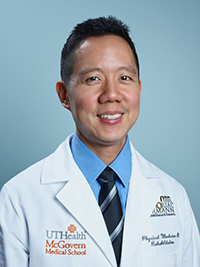
As medical director of the rehabilitation facility, he works closely with administrators at Memorial Hermann Greater Heights Hospital. “I’m more comfortable working with administration than I otherwise might have been,” says Dr. Huang, who is an assistant professor of physical medicine and rehabilitation at UTHealth. “The fellowship gave me a broader view of everything we have to balance in health care in terms of quality metrics and reimbursement by Medicare and other insurers. It gave me a solid head start on these issues.”
In addition to the clinical component his co-fellows received, Dr. Huang had regular monthly meetings with former TIRR Memorial Hermann CEO Carl Josehart. “Those meetings broke down the proverbial barrier between the physician and the C-suite for me – a relationship that many physicians consider adversarial. Having one-on-one contact with a CEO helped me understand his focus and his concerns. In doing so I learned that, at the core, physicians and administrators have similar goals and concerns, even though the means of addressing them may be different.”
As part of his fellowship, Dr. Huang initiated a process improvement project on sitter use on TIRR Memorial Hermann’s brain injury units, with the goal of looking at potential ways to more effectively use sitters in the acute inpatient rehabilitation setting. “In addition to reviewing numerous patient charts, I talked with various physicians, nurses, patient care assistants, therapists, families and hospital administrators about their view of sitter usage,” he recalls. “For more mobile patients with neurological issues that affected judgment and safety awareness, we normally had a one-to-one sitter-to-patient ratio. We considered using one sitter for two patients or, as an alternative, using telebots. It was clear through chart reviews and through my various interviews with staff that ordering sitters was done appropriately, but weaning them was often a delayed process. We noted that families who were highly involved with the patient’s care were valuable in assisting with the decision-making process of weaning from sitter usage. Some patients would have limited supervision after discharge, so the possibility of weaning them from sitter usage was an important issue.”
After completing his fellowship, Dr. Huang worked in private practice in the Chicago area for two years before being recruited back to TIRR Memorial Hermann as medical director of the Greater Heights rehabilitation facility. Today, he manages a 17-bed rehabilitation unit in which stroke is the most frequent rehabilitation diagnosis.
“We have a great group of therapists and nurses here who trained at TIRR Memorial Hermann,” he says. “During the two-and-a-half years of my tenure here, I’ve watched an acute inpatient unit morph into a TIRR-branded facility. We provide a similar level of care here as patients receive at TIRR Memorial Hermann and are equipped to handle the same diagnoses with the exception of patients on ventilators.”
“As a rehab unit within an acute care hospital, we are able to access all of the acute care specialists at Memorial Hermann Greater Heights to the same degree as the rest of the hospital,” he adds. “In this way, we offer our patients more than they can access at a freestanding rehabilitation hospital, where consulting physicians aren’t available at all times. Many of our patients and families prefer to be close to home, rather than traveling to the Texas Medical Center, so we’re pleased to be able to offer a high level of service here under the TIRR Memorial Hermann umbrella.”